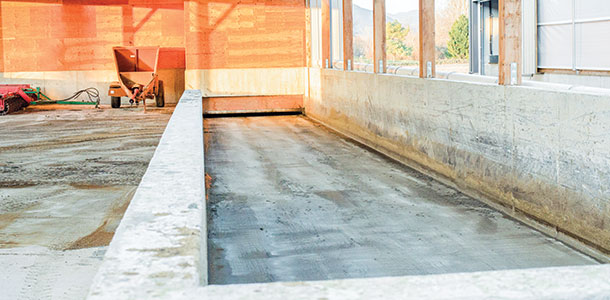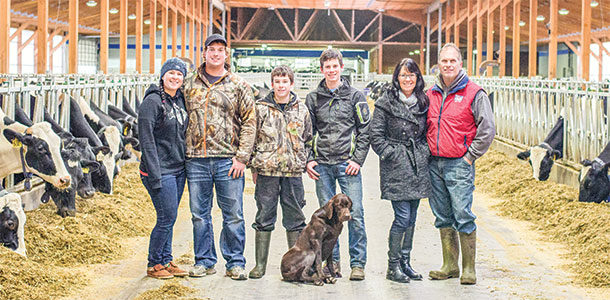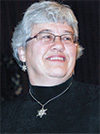Rosebrin Farms Ltd., located near Chilliwack, British Columbia, in the beautiful Fraser Valley, is the home of Brad and Lisa Roseboom and their family. Brad’s father established a dairy operation in the area in 1957, and Brad came home to farm in 1984. For a while, he farmed with his brother, but 11 years ago, he and Lisa established Rosebrin as a separate operation. Lisa says this decision was made with their four sons in mind as well as to provide an opportunity for their special-needs daughter, Melissa.
Over the years, their operation has hosted a number of farm tours, including travel groups from Japan, Europe and the U.S. It was also featured in this year’s BC Dairy Expo farm tours in late January.
Brad and Lisa are parents to eight children, four of which still live at home and help out with day-to-day chores. Their three oldest daughters are all married – Carina is married to Chris, with four children; Marlies is married to Will, with three children; and Larissa is married to Ritchie, with a new baby.
Their oldest son, Cameron, is out on his own. Melissa, along with the three youngest sons, Riley, Easton and Levi, are all at home. Levi, age 14, is the calf man, caring for the younger calves.
Ritchie has been a full-time hired man for six years, and a future partnership is a possibility. The Rosebooms also have one full-time employee, Sanessa, who has worked as a milker for the past two years. Melissa enjoys hanging out with and “helping” her in the milking parlor. During busy seasons, other family members will help out around the farm as well.
The Rosebooms work about 260 acres, growing their own forage crops – grass silage and hay. They purchase the grain they need and some extra hay as required.
The dairy herd consists of 450 head of commercial Holstein cattle. About 200 cows are milking at any given time; the remainder are dry cows and youngstock.
Brad recently built two new barns. The first is a drive-through barn for the milking herd. Completed in June, the new barn has 220 freestalls, which are deep-bedded with about 6 inches of sand.
The second new building, behind the dairy barn, holds the sand reclaiming system. Alley scrapers run every three hours, moving manure with sand into a 2-foot-wide flush flume, which deposits it into a 12-foot-square, 10-foot-deep pit.
Once it arrives in this pit, the slurry is pumped through an 8-inch line to the sand lane. Brad borrowed the idea for this from his friend and neighbor. The sand lane is a 100-foot-long, 11-foot-wide corridor with a slant of 0.75 percent.
This is sufficient to allow the sand to settle while the manure runs off with the liquids. Wastewater from the milking parlor is recaptured, pumped into the pit and run over the sand lane to further clean the sand. Once a day, the waste that is left in the pit is agitated and transferred to a large lagoon. The entire system is computer-controlled.

Brad has used sand for many years and praises it for helping to keep disease at bay. Coliform is virtually non-existent with sand bedding; he reports having none at all through the summer. This is the primary reason for choosing sand, but Brad has also found that sand assists in cow traction, keeping injuries from slippage to a minimum.
“In my mind, sand is king,” he states. He also cites benefits to the bottom line, as he is able to reclaim 80 to 90 percent of the sand used. Now he is comfortable using a lot of sand in the stalls, as he doesn’t lose much with the new system.
Cow comfort is addressed not only with the deep sand bedding but also with a number of grooming brushes spread around the barn. Brad says the brushes are in almost constant use.
The new barn is also equipped with LED lighting. This provides significant power savings, as one LED draws 78 watts and provides comparable lighting to one 250-watt metal halide light. There is a five-year warranty on light components, and each bulb is expected to last 100,000 hours. One 15-amp fuse controls 14 lights. To further sweeten that decision, the lights are North American-made.
In his spare time, Brad enjoys playing hockey, as do the three sons still at home. Camping, fishing and boating are other interests he pursues. A skiing holiday that includes all of the kids, spouses and grandkids is something the whole family enjoys. The younger boys are home-schooled, which gives the family more time to pursue their interests.
The Rosebooms are committed Christians and consider their faith and their family to be priorities. Sundays are spent at church and with their family, and it is not uncommon for the entire family to enjoy time and a meal together on Sunday afternoons. PD
Alice Guthrie is a freelance writer from Hagersville, Ontario.
PHOTOS
TOP: Family members active at Rosebrin Farms Ltd., include, left to right, Larissa and Ritchie Sheremeto, Levi, Easton, Lisa and Brad Roseboom.
BOTTOM: The sand lane is a 100-foot-long, 11-foot-wide corridor with a slant of 0.75 percent. This is sufficient to allow the sand to settle while the manure runs off with the liquids. Photos courtesy of Rosebrin Farms Ltd.







